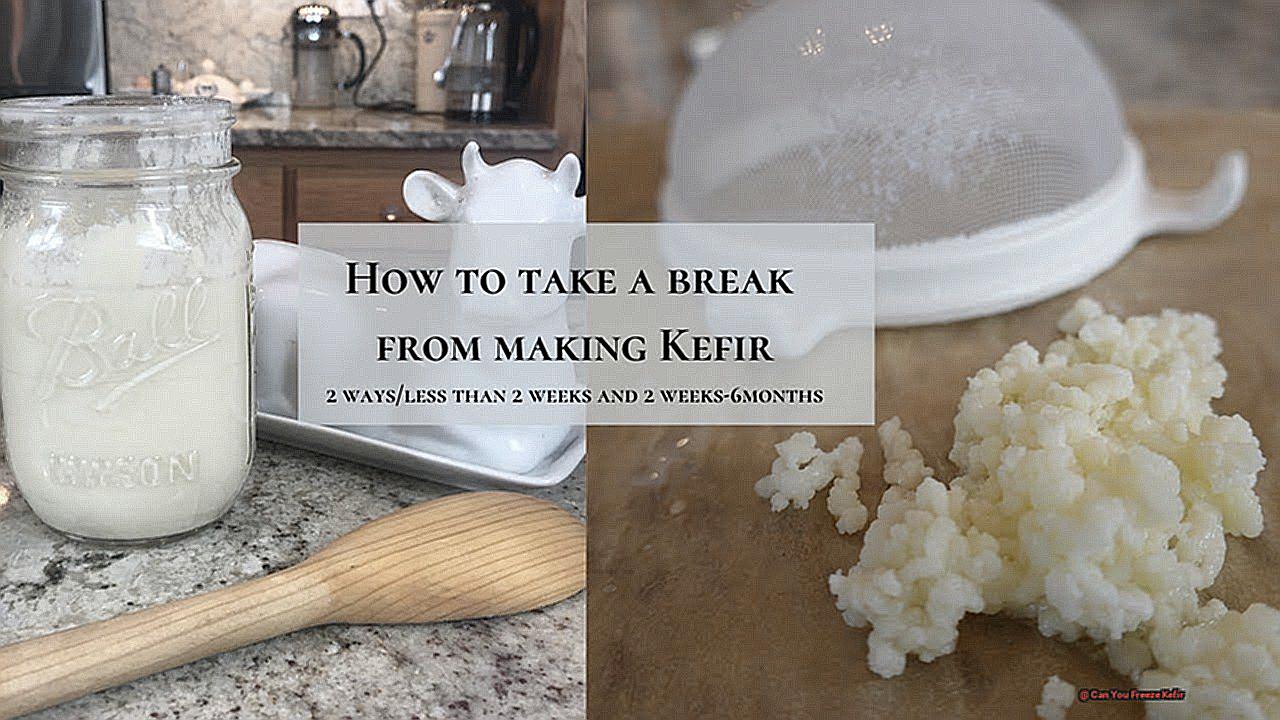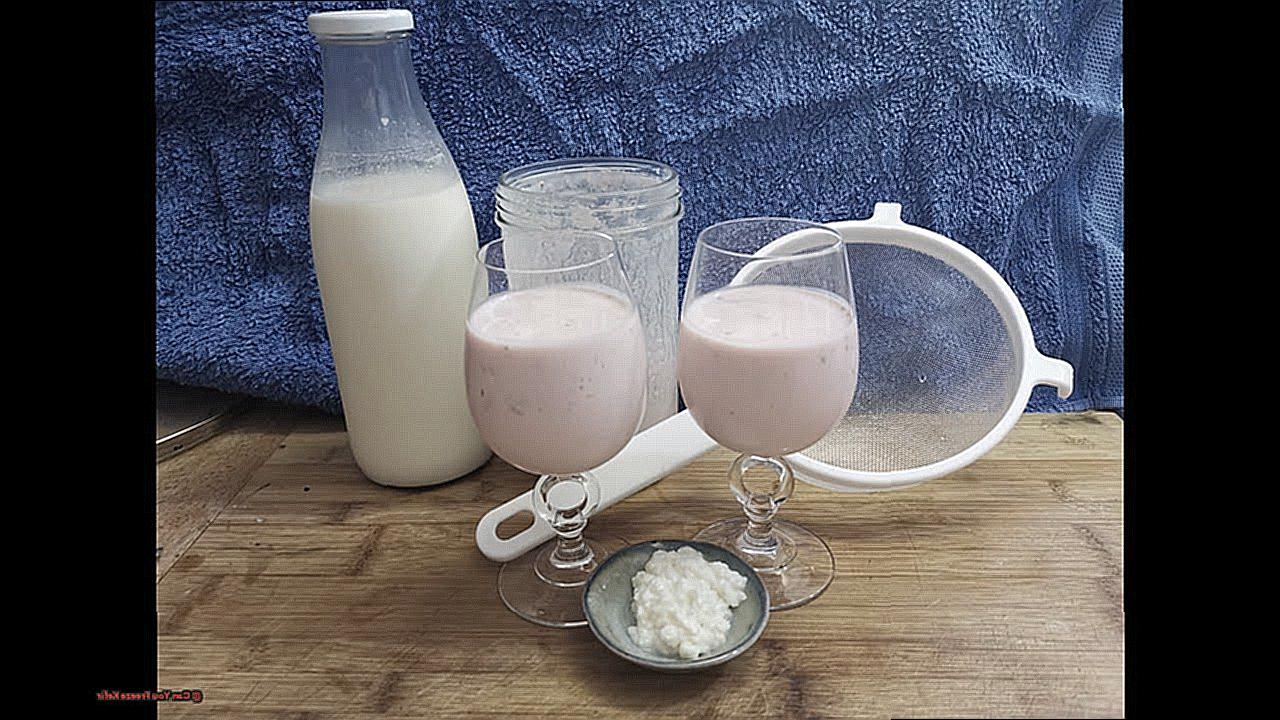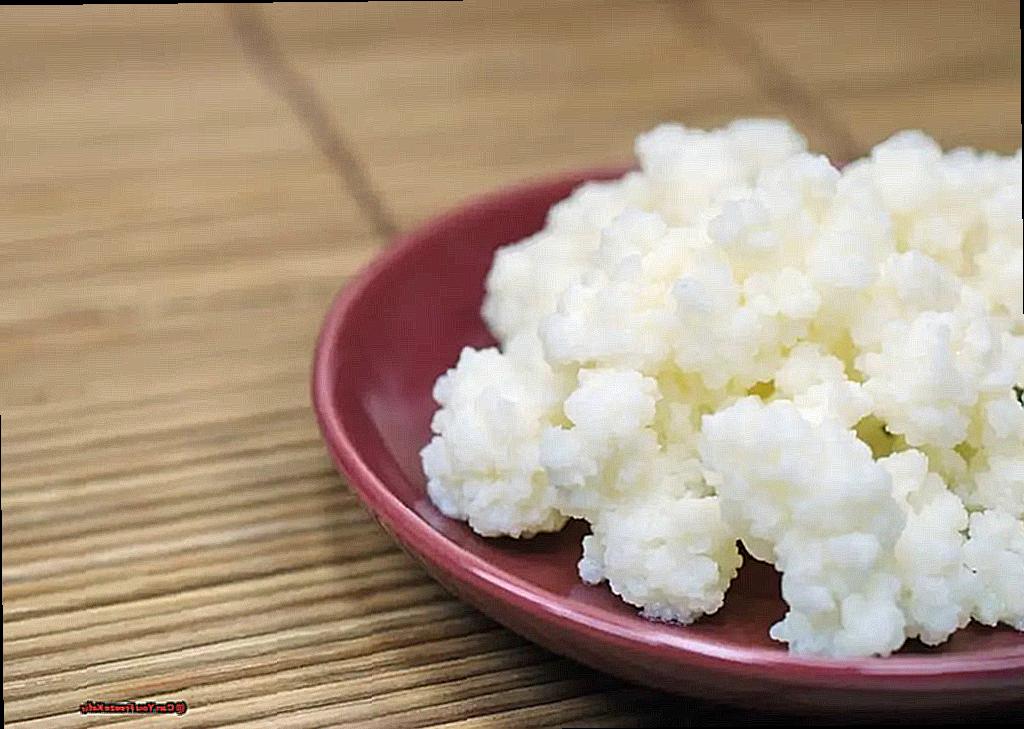Are you a kefir enthusiast, constantly on the lookout for ways to incorporate this tangy and nutritious drink into your daily routine?
Well, here’s some good news – you can now freeze your kefir and enjoy its goodness anytime you want. Yes, you heard it right.
Freezing kefir is a game-changer that not only extends its shelf life but also allows you to have a refreshing sip of this probiotic-rich beverage whenever the mood strikes. But before you rush to your freezer with a carton of kefir in hand, there are a few things you should know.
So grab your favorite flavor and let’s embark on an exciting journey of preserving this beloved drink.
Contents
- 1 Understanding Kefir and Its Benefits
- 2 Can Kefir Be Frozen?
- 3 Tips for Freezing Kefir
- 4 Freezing Homemade Kefir
- 5 Maintaining Quality When Freezing Kefir
- 6 Thawing and Using Frozen Kefir
- 7 Can You Refreeze Thawed Kefir?
- 8 Storing Frozen Kefir Long-Term
- 9 Other Considerations for Freezing Kefir
- 10 Conclusion
Understanding Kefir and Its Benefits
Kefir, a fermented dairy product made by combining milk with kefir grains, is a popular food known for its tart and tangy taste. It has been consumed for centuries in certain parts of the world, but in recent years, it has gained popularity due to its potential health benefits. In this article, we will delve into the potential benefits of consuming kefir and why it is worth adding to your diet.
Potential Health Benefits of Consuming Kefir:
| Rich in Nutrients | Kefir is a rich source of essential nutrients such as calcium, protein, and B vitamins. These nutrients are important for maintaining overall health and wellness. |
| Contains Probiotics | Kefir contains a variety of probiotics that can help maintain a healthy balance in the gut microbiome. These beneficial bacteria play a crucial role in supporting digestive health and boosting the immune system. |
| May Improve Digestive Health | The probiotics in kefir may help alleviate symptoms of digestive issues such as diarrhea, constipation, and inflammatory bowel disease. This can lead to improved gut health and better digestion. |
| May Boost Immune System | The probiotics in kefir may also help strengthen the immune system by promoting the growth of beneficial bacteria. This can help protect against infections and other illnesses. |
| Potential Anti-Cancer Properties | Some studies have shown that kefir may have anti-cancer properties due to its ability to inhibit the growth of cancer cells. This makes it a promising addition to cancer-fighting diets. |
| May Improve Bone Health | Kefir is a good source of calcium, which is essential for maintaining strong and healthy bones. This can help prevent conditions like osteoporosis and promote overall bone health. |
| May Help Reduce Inflammation | The probiotics in kefir may help reduce inflammation in the body, which is linked to many chronic diseases. This can lead to improved overall health and well-being. |
| May Lower Cholesterol and Blood Pressure | Some studies suggest that kefir may have a positive effect on lowering cholesterol levels and blood pressure. This can help reduce the risk of heart disease and improve cardiovascular health. |
| May Aid in Weight Loss | Kefir is a low-calorie, high-protein food that may help promote feelings of fullness and aid in weight loss. |
Can Kefir Be Frozen?
The answer is yes, it can. Freezing kefir does not alter its nutritional benefits or taste. However, the texture may be affected, so it is recommended to use defrosted kefir in cooked or baked dishes.
But why freeze kefir in the first place? Well, there are a few reasons. Maybe you bought too much and don’t want it to spoil, or perhaps you want to have some on hand for future use. Whatever the reason may be, freezing kefir is a great way to make sure you always have some on hand.
Now, let’s talk about how to freeze kefir properly. The best way to do so is by pouring it into an ice cube tray and freezing it that way. Once frozen, you can transfer the kefir cubes into a resealable bag or container for long-term storage. This method allows for easy portioning and defrosting as needed.
As mentioned earlier, freezing kefir may affect its texture. When defrosted, it may become slightly grainy or separated.
However, this will not affect its taste or nutritional benefits. If you plan on drinking the kefir as is, simply give it a good shake or stir before consuming.
But if you plan on using defrosted kefir in cooked or baked dishes, the texture change will not be noticeable at all.
Tips for Freezing Kefir
If you’re looking to preserve your probiotic-rich kefir for later use, freezing is a great option. However, it’s important to follow the proper steps to ensure the quality and flavor of your kefir is maintained. Here’s a simple guide to freezing and storing your kefir:
- Prepare your kefir smoothies by pouring them into suitable containers, leaving room for expansion.
- Seal the containers with tight lids, place them in a freezer bag, and label them with the contents and date.
- To maintain freshness and prevent bacterial growth, store the kefir smoothies in the coldest part of your freezer.
- When you’re ready to drink your frozen kefir, thaw it in the refrigerator for 24 hours.
- After thawing, give the kefir a good stir or whisk to restore its smooth and creamy consistency.
- Avoid refreezing partially thawed kefir as it can degrade its quality and introduce harmful bacteria.
- It’s important to note that freezing does not kill probiotics but rather puts them into a dormant state.
- If you prefer, you can also freeze probiotic drinks in an airtight container to prevent spoilage.
- Frozen kefir can be used as a base for homemade frozen treats or added to recipes such as soups or dressings.
- Keep in mind that different factors like packaging method and handling can affect the longevity of frozen kefir.
By following these steps, your frozen kefir can last for several months in the freezer. However, there are a few additional tips to keep in mind for the best quality and flavor:
- Use freezer-safe containers that seal tightly to prevent freezer burn.
- Thaw your kefir overnight in the refrigerator for a gradual temperature change.
- After thawing, give the kefir a good stir to fix any separation in texture.
- To ensure food safety, avoid refreezing partially thawed kefir smoothies.
- While freezing does not destroy probiotics, their populations may decrease by 15-50% over time.
So, freezing kefir is a practical way to preserve it for later use. By following these simple steps and tips, you can maintain the quality and flavor of your kefir while also enjoying the benefits of its probiotics.
Freezing Homemade Kefir
Extending the shelf life of homemade kefir is easily achievable by freezing it while preserving its probiotic benefits. However, to maintain its quality and beneficial properties, it is essential to follow proper techniques and methods. In this section, we will discuss the best method for freezing homemade kefir to ensure its probiotic benefits are retained.
METHODS FOR FREEZING HOMEMADE KEFIR:
- Use suitable containers: It is important to use freezer-safe containers such as mason jars or BPA-free plastic containers when freezing kefir. Leave some room at the top for expansion during freezing.
- Seal with lids: After pouring the kefir into containers, seal them tightly with lids to prevent air from entering and potentially affecting the quality.
- Place in a freezer bag: To further protect the kefir from contamination or freezer burn, place the sealed containers in a freezer bag. This also keeps them organized in the freezer.
- Label with contents and date: Labeling the frozen kefir with its contents and date frozen is crucial for keeping track of how long it has been frozen and when it should be used.
TIPS FOR THAWING AND STORING FROZEN KEFIR:
- Thaw properly: To thaw frozen kefir, transfer it to the fridge at least 24 hours before consuming. Thawing at room temperature can cause a grainy texture.
- Fully defrost before consuming: It is recommended to fully defrost the frozen kefir before consuming to maintain its smooth texture and taste.
- Avoid refreezing: Refreezing kefir is not recommended as it can degrade dairy milk and introduce harmful bacteria.
- Store in coldest part of freezer: For best quality, store frozen kefir in the coldest part of the freezer, such as the back or bottom shelf.
- Stir before consuming: After thawing, give the kefir a good stir or shake to incorporate any separated liquids and maintain its smooth texture.
Maintaining Quality When Freezing Kefir
To maintain the quality of your kefir when freezing it, here are some tips to follow:
- Start with high-quality ingredients: Begin by using fresh milk and live kefir grains to make your kefir. This will ensure that your kefir has all the necessary bacteria and yeast to ferment properly and maintain its probiotic properties even after freezing.
- Choose the right freezing temperature: The ideal temperature for freezing kefir is between -18°C to -20°C (-0.4°F to -4°F). Freezing at this temperature will prevent the formation of large ice crystals, which can damage the structure of the kefir.
- Freeze in smaller portions: Instead of freezing one large batch, it is best to freeze kefir in smaller portions. This will allow for quicker freezing and thawing times, reducing the risk of bacteria growth.
- Leave room for expansion: When filling the container, make sure to leave some space at the top as kefir will expand during freezing. Without enough space, the container may burst or crack, causing contamination and spoiling the kefir.
- Seal tightly: After filling the container, seal it tightly to prevent air from entering, as oxygen can affect the quality and taste of kefir.
- Thaw properly: To prevent large ice crystal formation, thaw frozen kefir in the refrigerator overnight. Avoid thawing at room temperature, as it can promote bacterial growth and spoilage.
- Stir before consuming: Once thawed, give your kefir a good stir to redistribute any separated solids. The texture of frozen kefir may be slightly different from fresh kefir due to the formation of ice crystals but can easily be fixed by blending or shaking before consumption.
- Consume within 2-3 months: While frozen kefir maintains its probiotic properties, some live cultures may not survive the freezing and thawing process. Therefore, it is recommended to consume frozen kefir within 2-3 months for optimal taste and health benefits.

| Ingredient | Fridge Shelf Life | Freezer Shelf Life |
| Homemade Kefir | 5 to 7 days | 2 to 3 months |
| Store-bought Kefir | 7 to 10 days | 2 to 3 months |
| Kefir grains | N/A (can be stored in the fridge) | N/A (can be stored in the freezer) |
Remember to always label your containers with the contents and date before placing them in the freezer.
Thawing and Using Frozen Kefir
Thawing frozen kefir is an essential process to guarantee its safety and quality. Improper thawing can result in contamination and spoilage, rendering the kefir unsafe to consume. In this section, we will discuss the best ways to safely thaw and use frozen kefir.
Thawing Frozen Kefir in the Fridge:
The optimal method to thaw frozen kefir is by placing it in the refrigerator overnight. This gradual thawing process helps maintain the integrity of the kefir and prevents the growth of harmful bacteria. To do this, simply remove the frozen kefir from the freezer and place it in the fridge. Be sure to leave it in its original container or transfer it to a clean, airtight container if it is not packaged correctly.
Thawing Frozen Kefir in Cold Water:
For those who are pressed for time, another option is to thaw the kefir in a bowl of cold water. However, this approach should only be used if the kefir is packaged in a waterproof container to prevent any water from entering and diluting it. To do this, place the sealed container of frozen kefir in a bowl of cold water and let it sit until it is completely thawed. It is important to monitor the water temperature and change it as needed to ensure that it stays cold.
Using Thawed Frozen Kefir:
Once the kefir is fully thawed, give it a good stir or shake before consuming. This helps redistribute any separation that may have occurred during freezing. The texture and consistency of thawed frozen kefir may differ slightly compared to fresh kefir due to the formation of ice crystals during freezing. However, this does not affect its taste or nutritional value.
Consumption of Thawed Frozen Kefir:
It is crucial to consume thawed frozen kefir within 2-3 days to ensure its freshness and safety. If you have leftover kefir that you will not be able to consume within this time frame, it is best to freeze it again until you are ready to use it.
Important Tips to Keep in Mind:
- Refreezing thawed frozen kefir is not recommended.
- Opt for high-quality kefir with a diverse range of probiotic strains for maximum benefits.
- Thawed frozen kefir can be used in smoothies, baked goods, or as a substitute for sour cream.
- Thawing in the fridge or cold water and stirring before consumption are vital steps to ensure the safety and quality of the kefir.
Thawing and using frozen kefir can be done safely by following these tips. Proper thawing and consumption within a few days will help maintain the integrity of the kefir and ensure its safety for consumption.
Can You Refreeze Thawed Kefir?
Re-freezing thawed kefir is not typically advised, as it can greatly affect the texture, taste, and overall quality of the beverage. Freezing causes ice crystals to form, which can damage the structure of the kefir and lead to separation when thawed. Re-freezing only causes more ice crystals to form, causing further damage to the beverage.
However, if you find yourself with more thawed kefir than you can consume, there are precautions you can take to potentially salvage it. If you must re-freeze the kefir, do so immediately and store it at a temperature of 0°F (-18°C). It is important to note that re-freezing will compromise the quality and texture of the kefir, so it is best to use it in cooking or smoothies rather than consuming it on its own.
| Stage | Safe to Consume? | Storage Recommendations |
| Frozen | Yes | – Store in freezer at 0°F (-18°C) – Can be kept for up to 6 months |
| Thawed in Fridge | No | – Must be consumed within 2 days – Do not refreeze |
| Thawed in Cold Water | No | – Must be consumed immediately – Do not refreeze |
| Refrozen After Thawing | No | – Quality and texture may be compromised – Do not refreeze if possible – If necessary, use in cooking or smoothies rather than consuming it on its own. |
If you do find yourself with excess thawed kefir, it is best to use it in cooking or smoothies rather than consuming it on its own. This will help mask any changes in texture or taste that may have occurred due to re-freezing.
It is important to keep in mind that re-freezing kefir multiple times increases the risk of bacterial growth and can potentially cause food poisoning. Therefore, proper handling and storage of kefir is crucial in order to minimize the need for re-freezing.
While it is generally not recommended to re-freeze thawed kefir, it is possible in certain situations. However, it is important to take precautions and use the re-frozen kefir in cooking or smoothies rather than consuming it on its own.
Storing Frozen Kefir Long-Term
When it comes to storing frozen kefir long-term, there are several crucial considerations to keep in mind. These include the duration for which it can be stored, the appropriate storage method, and the potential impact on its flavor and consistency. As an expert on this topic, I have compiled all the necessary information to ensure that your frozen kefir remains safe and delectable for extended periods.
How Long Can Frozen Kefir Be Stored For?
Frozen kefir can be safely stored for up to three months without any significant degradation in quality. This is due to the presence of beneficial bacteria in kefir that can withstand freezing temperatures. However, for optimal taste and texture, it is recommended to consume frozen kefir within one month of freezing.
Proper Storage Method for Frozen Kefir:
To properly store frozen kefir, it is essential to use suitable containers that can withstand freezing temperatures. Glass jars or plastic containers with lids are excellent options. When freezing kefir, make sure to leave some room for expansion in the container. Once filled, seal with a lid, place in a freezer bag, and label with the contents and date before placing it in the freezer.
Effects on Taste and Texture:
It is important to note that freezing and re-freezing thawed kefir can significantly affect its texture, taste, and overall quality. Therefore, it is recommended to use frozen kefir in cooking or smoothies rather than consuming it on its own after thawing. This will help maintain its taste and texture.
In conclusion, frozen kefir can be safely stored for up to three months without any considerable impact on its quality. However, for best results, it is advisable to consume it within one month of freezing.
Other Considerations for Freezing Kefir
In addition to the basic steps of freezing kefir, there are a few extra tips to keep in mind for optimal quality and flavor when using your frozen kefir.
- Choose freezer-safe containers with tight seals: It is important to use specialized containers designed for freezing when storing your kefir in the freezer. These containers should have tight seals to prevent air and moisture from affecting the quality and taste of the kefir.
- Leave space for expansion: As kefir expands when frozen, make sure to leave some room at the top of the container to avoid bursting or leaking.
- Use within 6 months: While frozen kefir can last up to 3 months, it is best to use it within 6 months for maximum quality.
Do not refreeze: Once thawed, do not refreeze kefir as it can affect its texture and taste.
- Thaw slowly in the fridge: For best results, thaw frozen kefir overnight in the fridge. This slow process helps preserve the probiotics and maintain the texture and taste of the kefir.
- Use lukewarm water for quick thawing: If you need to use your kefir immediately, you can thaw it in lukewarm water for 1-2 hours. Avoid using hot water as it can kill off probiotics.
- Heat on stove for immediate use: Thawed kefir can also be heated on the stove for immediate use, perfect for warm dishes like soups or stews.
Conclusion
In conclusion, freezing kefir is a game-changer for avid fans of this tangy and nutritious drink. This article has delved into the potential health benefits of incorporating kefir into your daily routine.
It has also provided a detailed guide on how to properly freeze homemade kefir, as well as tips for preserving its quality and flavor. Furthermore, this piece has explored creative ways to use thawed frozen kefir in various dishes.
Don’t let any extra kefir go to waste – freeze it and savor its goodness at your convenience.






